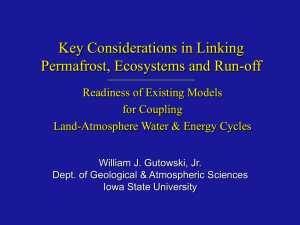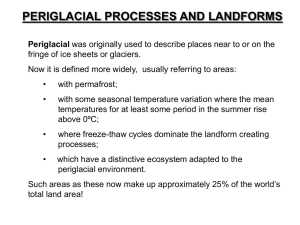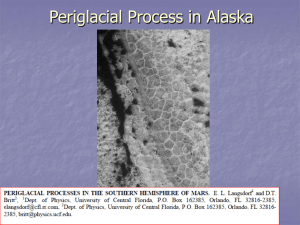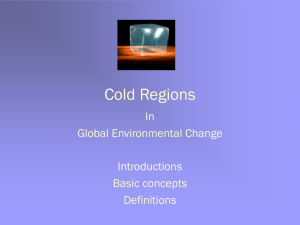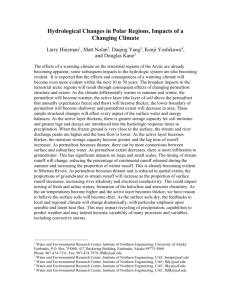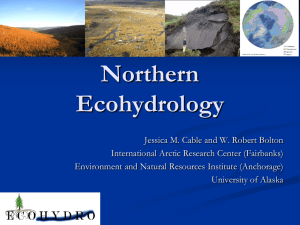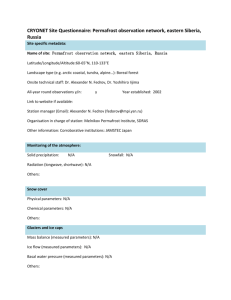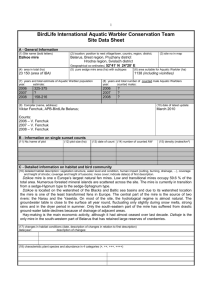WORD - NIA - Elizabeth City State University
advertisement
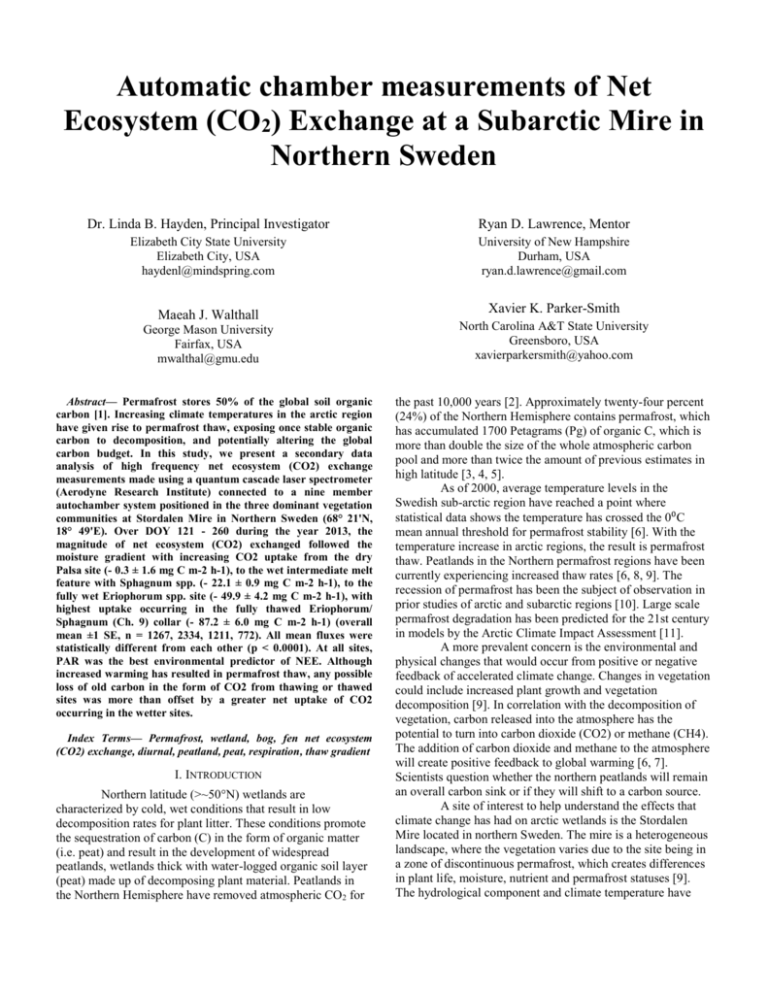
Automatic chamber measurements of Net Ecosystem (CO2) Exchange at a Subarctic Mire in Northern Sweden Dr. Linda B. Hayden, Principal Investigator Ryan D. Lawrence, Mentor Elizabeth City State University Elizabeth City, USA haydenl@mindspring.com University of New Hampshire Durham, USA ryan.d.lawrence@gmail.com Maeah J. Walthall George Mason University Fairfax, USA mwalthal@gmu.edu Abstract— Permafrost stores 50% of the global soil organic carbon [1]. Increasing climate temperatures in the arctic region have given rise to permafrost thaw, exposing once stable organic carbon to decomposition, and potentially altering the global carbon budget. In this study, we present a secondary data analysis of high frequency net ecosystem (CO2) exchange measurements made using a quantum cascade laser spectrometer (Aerodyne Research Institute) connected to a nine member autochamber system positioned in the three dominant vegetation communities at Stordalen Mire in Northern Sweden (68° 21'N, 18° 49'E). Over DOY 121 - 260 during the year 2013, the magnitude of net ecosystem (CO2) exchanged followed the moisture gradient with increasing CO2 uptake from the dry Palsa site (- 0.3 ± 1.6 mg C m-2 h-1), to the wet intermediate melt feature with Sphagnum spp. (- 22.1 ± 0.9 mg C m-2 h-1), to the fully wet Eriophorum spp. site (- 49.9 ± 4.2 mg C m-2 h-1), with highest uptake occurring in the fully thawed Eriophorum/ Sphagnum (Ch. 9) collar (- 87.2 ± 6.0 mg C m-2 h-1) (overall mean ±1 SE, n = 1267, 2334, 1211, 772). All mean fluxes were statistically different from each other (p < 0.0001). At all sites, PAR was the best environmental predictor of NEE. Although increased warming has resulted in permafrost thaw, any possible loss of old carbon in the form of CO2 from thawing or thawed sites was more than offset by a greater net uptake of CO2 occurring in the wetter sites. Index Terms— Permafrost, wetland, bog, fen net ecosystem (CO2) exchange, diurnal, peatland, peat, respiration, thaw gradient I. INTRODUCTION Northern latitude (>~50°N) wetlands are characterized by cold, wet conditions that result in low decomposition rates for plant litter. These conditions promote the sequestration of carbon (C) in the form of organic matter (i.e. peat) and result in the development of widespread peatlands, wetlands thick with water-logged organic soil layer (peat) made up of decomposing plant material. Peatlands in the Northern Hemisphere have removed atmospheric CO2 for Xavier K. Parker-Smith North Carolina A&T State University Greensboro, USA xavierparkersmith@yahoo.com the past 10,000 years [2]. Approximately twenty-four percent (24%) of the Northern Hemisphere contains permafrost, which has accumulated 1700 Petagrams (Pg) of organic C, which is more than double the size of the whole atmospheric carbon pool and more than twice the amount of previous estimates in high latitude [3, 4, 5]. As of 2000, average temperature levels in the Swedish sub-arctic region have reached a point where statistical data shows the temperature has crossed the 0⁰C mean annual threshold for permafrost stability [6]. With the temperature increase in arctic regions, the result is permafrost thaw. Peatlands in the Northern permafrost regions have been currently experiencing increased thaw rates [6, 8, 9]. The recession of permafrost has been the subject of observation in prior studies of arctic and subarctic regions [10]. Large scale permafrost degradation has been predicted for the 21st century in models by the Arctic Climate Impact Assessment [11]. A more prevalent concern is the environmental and physical changes that would occur from positive or negative feedback of accelerated climate change. Changes in vegetation could include increased plant growth and vegetation decomposition [9]. In correlation with the decomposition of vegetation, carbon released into the atmosphere has the potential to turn into carbon dioxide (CO2) or methane (CH4). The addition of carbon dioxide and methane to the atmosphere will create positive feedback to global warming [6, 7]. Scientists question whether the northern peatlands will remain an overall carbon sink or if they will shift to a carbon source. A site of interest to help understand the effects that climate change has had on arctic wetlands is the Stordalen Mire located in northern Sweden. The mire is a heterogeneous landscape, where the vegetation varies due to the site being in a zone of discontinuous permafrost, which creates differences in plant life, moisture, nutrient and permafrost statuses [9]. The hydrological component and climate temperature have impacting effects on the environment and the atmospheric sink function of the peatlands [9]. The thawing of permafrost increases the hydrologic levels which produce more pond-like areas [6]. It has been shown that moisture impacts microbial activity [12]. The increase in moisture and nutrients due to the degradation of permafrost enhance conditions for CO2 and CH4 to be emitted in the atmosphere [16]. In this study, we performed a secondary data analysis of net ecosystem (CO2) exchange (NEE) measurements and environmental conditions (i.e. PAR, air and ground temperature) collected along a natural permafrost thaw gradient from DOY 121 - 260, year 2013. II. METHODOLOGY A. Site Description Stordalen Mire (10 km east of Abisko of northern Sweden (68° 21'N, 18° 49’E, altitude 363 m above sea level) has been the focus of many investigations and research concerning decadal vegetation, trace gas emissions, and climate change due to its location within the Arctic circle [6, 9, 12, 13, 14, 15]. Stordalen is characterized as a palsa mire underlain with patchy, sporadic permafrost. The areas within the mire nearby each other have a variety of moisture and nutrient status ranges [9]. The annual temperature at Abisko Scientific Research Station of 0.07°C with 308 mm of accumulated precipitation (1986-2006 20 year mean) [15]. The research focused on three different sub-habitats that have the most dominant presence in Stordalen and common to northern wetlands. The three communities are i) drained palsas underneath woody herbaceous (permafrost), ii) intermediate permafrost sites where the water table fluctuates close to the ground, dominated by Sphagnum, and iii) wet sites where the ground completely thawed in the summer, wet areas containing Eriophorum. For the sake of this research we will refer to the three sites as the palsa site, Sphagnum site, and Eriophorum site. Together, the three vegetation communities cover 98% of Stordalen Mire. The palsa site coverage extends 49% of Stordalen, the Sphagnum site expands over 37%, and Eriophorum reach 12% of the mire [14]. The fourth site is a transition collar between the Eriophorum and Sphagnum sites [10]. B. Automatic Chamber System and Quantum Cascade Laser Spectrometer Measurements The automatic chamber system has been fully described in earlier papers [15, 17]. The chamber system was updated in 2011 with the addition of a ninth chamber [(n = 3 each at the Palsa and Sphagnum site, n = 2 Eriophorum site, n = 1 at the Eriophorum/Sphagnum collar, designated as Ch. 9). The chambers are closed every 3 hours for 5 minutes, approximately 3% of everyday. C. Measurements of Net Ecosystem (CO2) Exchange The NEE between an ecosystem and the atmosphere is the net result of the competing flux processes of gross primary production (GPP, photosynthetic CO2 uptake) and total ecosystem respiration (TER, autotrophic and heterotrophic CO2 production). Net uptake of CO2 fluxes were calculated using the standard procedure. All fluxes (positive or negative; n = 13,527) with r2 < 0.87 (minimum necessary for 95% confidence limits) were eliminated, resulting in 47% of the data being discarded (n = 6,411). D. Environmental Variables In addition to the trace gas data, ground and air temperature were recorded within each chamber, while photosynthetically active radiation (PAR) was measured at the top of the automatic chamber system shelter. The data was continuously logged by the automatic chamber system previously described. E. Data Analysis We distinguished day and night CO2 fluxes to account for diurnal fluctuations. The sun does not set during this time of year in areas located 180 km above the Arctic Circle, but during the period where the sun is at its lowest angle, calm cool periods are induced due to surface cooling. Based on light and temperature variability during 24 hour periods, daytime was determined to be from 10:30 am to 3:30 pm and night time was from 9:30 pm to 2:30 am [10]. For this study, CO2 uptake by the ecosystem is negative and emitted CO2 is positive. . III. CONCLUSION The purpose of this research was to determine whether or not the Stordalen Mire would maintain the status of an atmospheric C sink or become an atmospheric C source after the effects of climate change. In conclusion, the data for the green season of 2013 revealed that the entire Stordalen Mire site remained a carbon sink. The calculated mean of NEE was recorded as -32.207 mgCm-2h-1 for the whole peatland showing consistent uptake during the green season. The same can be concluded for each individual site within mire. The palsa site recorded -0.394 mgCm-2h-1 which was the lowest atmospheric sink site. Next came the Sphagnum site with 22.12 mgCm-2h-1. The highest average C uptake present in the mire was found at the Eriophorum site with -49.935 mgCm-2h1 and the Eriophorum/Sphagnum (Ch.9) site with -87.196 mgCm-2h-1. The Eriophorum and Ch.9 sites were the largest carbon sinks of the mire, with the transition collar, Ch. 9, having the largest uptake of CO2. The regression analysis performed showed that out of the three environmental variables tested, PAR explained most of the data with the highest r2 value for the whole mire and each individual site. This could be due to the strong impact photosynthesis has on the uptake of carbon. IV. FUTURE WORKS For the future work we plan to study the water table depth to have an understanding of the hydrology of the sites. Hydrological functions influence microbial communities that can have an effect on the production either CO2 or CH4. The water table depth also provides clarity to the extent of the permafrost thaw. In addition to the water table depth, we also plan to look at measurements of the active layer. The active layer depth increases as the permafrost thaws. Documentation of the changes in the active layer on an extensive period of time can indicate the amount of permafrost that is lost. Both of these would be used as environmental variables to further develop insight on their effect on NEE. climate era in the sub-Arctic: Accelerating climate changes and multiple impacts,” Geophys. Res. Lett., vol. 37, no. 14, pp. 1–6, 2010. [7] IPCC, 2007: Climate Change 2007: The Physical Science Basis. Contribution of Working Group I to the Fourth Assessment Report of the Intergovernmental Panel on Climate Change [Solomon, S., D. Qin, M. Manning, Z. Chen, M. Marquis, K.B. Averyt, M.Tignor and H.L. Miller (eds.)]. Cambridge University Press, Cambridge, United Kingdom and New York, NY, USA. [8] P. Camill, “Permafrost thaw accelerates in boreal peatlands during late-20th century climate warming,” Clim. Change, vol. 68, no. 1–2, pp. 135–152, 2005. [9] N. Malmer, T. Johansson, M. Olsrud, and T. R. Christensen, “Vegetation, climatic changes and net carbon sequestration in a North-Scandinavian subarctic mire over 30 years,” Glob. Chang. Biol., vol. 11, no. 11, pp. 1895–1909, 2005. [10] K. Bäckstrand, P. M. Crill, M. Mastepanov, T. R. Christensen, and D. Bastviken, “Total hydrocarbon flux dynamics at a subarctic mire in northern Sweden,” J. Geophys. Res. Biogeosciences, vol. 113, no. 3, 2008. [11] ACIA, 2005. Arctic Climate Impact Assessment. ACIA Overview report. Cambridge University Press. 1020 pp. [12] C. K. Mccalley, B. J. Woodcroft, S. B. Hodgkins, R. a Wehr, E. Kim, R. Mondav, P. M. Crill, J. P. Chanton, V. I. Rich, G. W. Tyson, and S. R. Saleska, “Methane dynamics regulated by microbial,” Nature, vol. 514, no. 7523, pp. 478–481, 2014. [13] a. Malhotra and N. T. Roulet, “Environmental correlates of peatland carbon fluxes in a thawing landscape: do transitional thaw stages matter?,” Biogeosciences, vol. 12, no. 10, pp. 3119– 3130, 2015. [14] T. Johansson, N. Malmer, P. M. Crill, T. Friborg, J. H. Åkerman, M. Mastepanov, and T. R. Christensen, “Decadal vegetation changes in a northern peatland, greenhouse gas fluxes and net radiative forcing,” Glob. Chang. Biol., vol. 12, no. 12, pp. 2352–2369, 2006. [15] K. Bäckstrand, P. M. Crill, M. Jackowicz-Korczyński, M. Mastepanov, T. R. Christensen, and D. Bastviken, “Annual carbon gas budget for a subarctic peatland, ACKNOWLEDGMENT The Arctic team thanks Dr. Linda Hayden who served as the director of the Elizabeth City State University Research Experience for Undergraduates Program as well as the principal investigator to the research; Dr. Patrick Crill, who corresponded with the team during the research process; and Mr. Ryan Lawrence, mentor of the Arctic Team. The team would also like to acknowledge CReSIS and the National Science foundation for funding the research. REFERENCES [1] E. a G. Schuur, J. Bockheim, J. Canadell, E. Euskirchen, C. B. Field, S. V Goryachkin, S. Hagemann, P. Kuhry, P. Lafleur, H. Lee, G. Mazhitova, F. E. Nelson, a R. V., Romanovsky, N. Shiklomanov, C. Tarnocai, S. Venevsky, J. G. Vogel, and S. a Zimov, “Vulnerability of permafrost carbon to climate change: implications for the global carbon cycle,” Bioscience, vol. 58, no. 8, pp. 704–714, 2008. [2] G. M. Macdonald, D. W. Beilman, K. V Kremenetski, Y. Sheng, L. C. Smith, and A. a Velichko, “Rapid early development of circumarctic peatlands and atmospheric CH4 and CO2 variations.,” Science, vol. 314, no. 5797, pp. 285–288, 2006. [3] a Vaks, O. S. Gutareva, S. F. M. Breitenbach, E. Avirmed, a J. Mason, a L. Thomas, a V Osinzev, a M. Kononov, and G. M. Henderson, “Speleothems reveal 500,000-year history of Siberian permafrost.,” Science, vol. 340, no. 6129, pp. 183–6, 2013. [4] C. Tarnocai, J. G. Canadell, E. a G. Schuur, P. Kuhry, G. Mazhitova, and S. Zimov, “Soil organic carbon pools in the northern circumpolar permafrost region,” Global Biogeochem. Cycles, vol. 23, no. 2, pp. 1–11, 2009. [5] E. Applications and N. May, “Northern Peatlands : Role in the Carbon Cycle and Probable Responses to Climatic Warming Eville Gorham NORTHERN PEATLANDS : ROLE IN THE CARBON CYCLE AND PROBABLE RESPONSES TO CLIMATIC WARMING1,” vol. 1, no. 2, pp. 182–195, 1991. [6] T. V. Callaghan, F. Bergholm, T. R. Christensen, C. Jonasson, U. Kokfelt, and M. Johansson, “A new northern Sweden,” Medd. fran Lunds Univ. Geogr. Institutioner, Avh., no. 184, pp. 53–65, 2009. [16] T. R. Christensen, “Thawing sub-arctic permafrost: Effects on vegetation and methane emissions,” Geophys. Res. Lett., vol. 31, no. 4, 2004. [17] Hodgkins, S. B., Tfaily, M. M., McCalley, C. K., Logan, T. A., Crill, P. M., Saleska, S. R., Rich, V. I., and Chanton, J. P.: Changes in peat chemistry associated with permafrost thaw increase green- house gas production., Proc. Natl. Acad. Sci. USA, 111, 5819– 24, 2014
